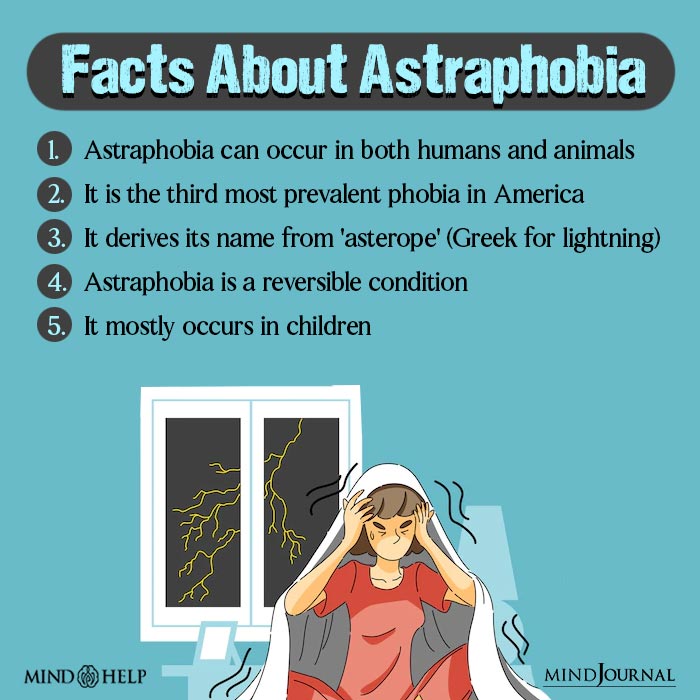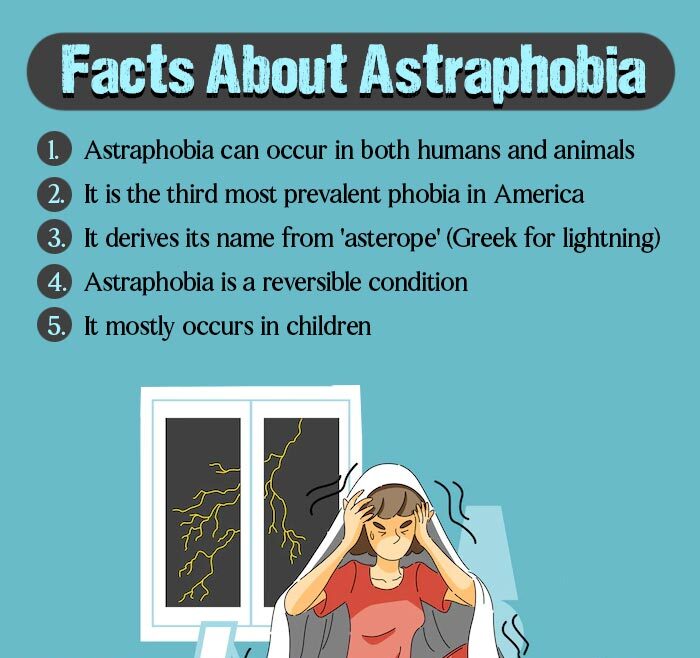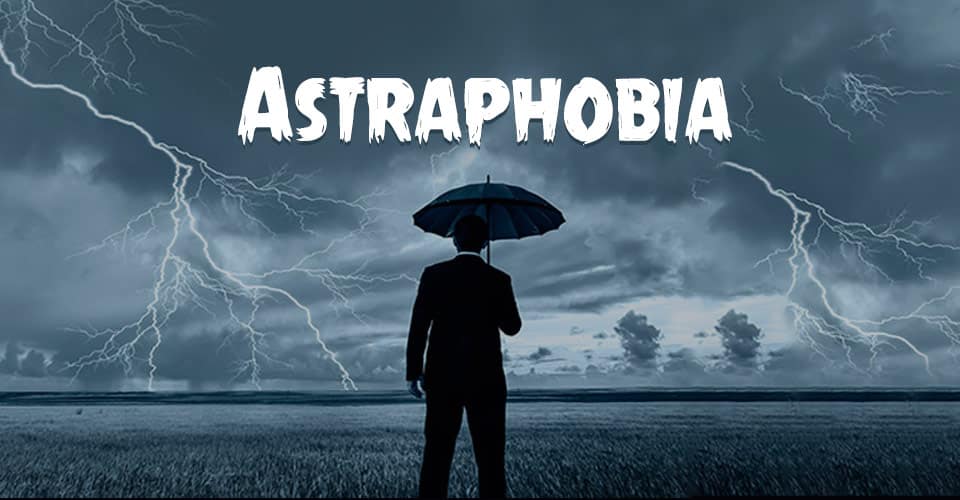Astraphobia is an irrational fear of thunder and lightning. It can cause intense anxiety and fear, seriously affecting different aspects of a person’s life. It is also known as tonitrophobia.
What Is Astraphobia?
Astraphobia is an extreme and aberrant fear of thunder, lightning, and thunderstorms that affects a person’s ability to function in everyday life. It is a specific phobia that can be observed in both humans and animals.
This disorder can affect individuals of all ages but is experienced more by children than adults. Most children tend to overcome it as they grow older but some may experience it throughout their adult lives. Some adults who have never experienced it before in their childhood may also develop the condition later in their life.
The term “astraphobia” is composed of the Greek words “astrape” meaning lightning and “phobos” meaning fear. It is also known as:
- Tonitrophobia
- Brontophobia
- Keraunophobia
- Ceraunophobia
Astraphobia is generally experienced more by people who live or work in regions with frequent and severe stormy weather.
While preparing for thunderstorms or getting caught up in extreme weather conditions can make anyone feel reasonably anxious or afraid, people with astraphobia tend to have an intense and excessive phobic reaction to lightning and thunder. Individuals suffering from this specific phobia feel overwhelmed, devastated, and overpowered.
However, as specific phobias (like astraphobia) have originated due to evolution, some experts consider that fear of thunder and lightning is not exactly a phobia but an evolutionary tool designed to ensure our survival.
Irrespective of the controversy surrounding its cause, numerous people across the world are affected by this condition and experience intense fear and anxiety during bad weather. In fact, according to a 2017 study [mfn] Coon, D., Mitterer, J. O., & Martini, T. S. (2020). Introduction to psychology: Gateways to mind and behavior (with APA card). Cengage Learning. [/mfn], astraphobia is the third most prevalent specific phobia among Americans.

Read More About Phobia Here
Case Example
When Rima was 7 years old, she heard a story of a man who had died after being struck by lightning. Since then, soon as there was rain and thunder, she would lock herself up in a room and crouch in a corner refusing to come out until it stops.
She also had trouble swallowing any food whenever she heard thunder outside. During thunderstorms, Rima would often go for days without eating or sleeping properly.
With time, Rima would start feeling anxious in anticipation of thunder and lightning as soon as the sky went dark. She was in perpetual fear of being stuck outside in a thunderstorm. During monsoons, she missed a lot of days at school and this started affecting her academic performance and peer relationships as well.
Case Analysis
From the instance above, it seems clear that Rima experienced an extreme and debilitating fear of thunder and lightning, also known as astraphobia, which was affecting her school performance and friendships. She was not only anxious and extremely uncomfortable during thunderstorms but also in anticipation of them.
Symptoms Of Astraphobia
People with astraphobia not only experience intense fear and discomfort but may also experience full-blown panic attacks, depending on the intensity of the condition.
In extreme cases, hospitalization may also be required. A noticeable obsession with weather forecasts is perhaps one of the most common astraphobia symptoms.
Here are some of the other common symptoms of astraphobia in adults.

1. Physical symptoms
When exposed to a thunderstorm, people with astraphobia may experience overwhelming feelings of anxiety and panic attacks characterized by real physical symptoms, such as
- Sweating
- Trembling
- Shortness of breath or difficulty in breathing
- Nausea
- Hyperventilation
- Headaches and dizziness
- A rise in blood pressure
2. Psychological symptoms
Some psychological symptoms common among people suffering from astraphobia are
- Intense fear and anxiety
- Fear of losing control/ consciousness
- Anxiety about the possibility of thunderstorms
- Anger
- Irritability
- Mood swings
- Fear of dying
Astraphobia in Children
The fear of thunder is very common in childhood. Their phobia is characterized by signs of extreme anxiety including
- Pacing
- Repetitive speech
- Yelling
- Crying
- Clinging
- Aggression
- Self-injury
Some strategies to help children who suffer from astraphobia have been mentioned at the end of this article.
What Causes Astraphobia?
Both genetics and environmental causes [mfn] Loken, E., Hettema, J., Aggen, S., & Kendler, K. (2014). The structure of genetic and environmental risk factors for fears and phobias. Psychological Medicine, 44(11), 2375-2384. doi:10.1017/S0033291713003012 [/mfn] are attributed to the development of astraphobia.
Some common risk factors and causes of astraphobia may include
- Family history of phobia or other mental health conditions, such as anxiety or depression
- Traumatic experiences (eg; surviving a cyclone or hurricane)
- A history of other anxiety disorders, or phobias
- Autism [mfn] Garcia R. (2017). Neurobiology of fear and specific phobias. Learning & memory (Cold Spring Harbor, N.Y.), 24(9), 462–471. https://doi.org/10.1101/lm.044115.116 [/mfn]
Apart from this, evolution is also a contributing factor in the genesis of this phobia, as mentioned earlier. Being afraid of loud noises ensured that our ancestors survived threats and dangers. So this particular phobia [mfn] Asha’ari, Z. A., Mat Zain, N., & Razali, A. (2010). Phonophobia and hyperacusis: practical points from a case report. The Malaysian journal of medical sciences : MJMS, 17(1), 49–51. [/mfn] may have served as a survival mechanism.
Read More About Autism Here
Diagnosis Of Astraphobia
Astraphobia is diagnosed as a specific phobia in the Diagnostic and Statistical Manual of Mental Disorders (DSM) 5 [mfn] Substance Abuse and Mental Health Services Administration. (2016). Impact of the DSM-IV to DSM-5 Changes on the National Survey on Drug Use and Health. Substance Abuse and Mental Health Services Administration (US). Available from: https://www.ncbi.nlm.nih.gov/books/NBK519704/table/ch3.t11/ [/mfn].
A mental health professional usually takes a detailed history of the symptoms before making a diagnosis. There are no medical tests for the diagnosis of phobia. However, clinicians may use some assessments to understand the symptoms and their severity.
The Behavioral Approach Test (BAT) [mfn] Antony, M. M. (2021). Specific Phobia: A Brief Overview and Guide to Assessment. Practitioner’s Guide to Empirically Based Measures of Anxiety, 127–132. https://doi.org/10.1007/0-306-47628-2_11 [/mfn] is one of the most important and widely used diagnostic scales for specific phobias such as astraphobia, or as it is clinically called, tonitrophobia.
How To Treat Astraphobia
Like any other phobia, a combination of psychotherapy and medication can help a person suffering from astraphobia overcome its symptoms.
Mentioned below are some commonly used astraphobia treatment methods:
1. Therapy
Several therapy techniques [mfn] Öst, L. (1978). Behavioral treatment of thunder and lightning phobias. Behaviour Research and Therapy, 16(3), 197-207. https://doi.org/10.1016/0005-7967(78)90067-0 [/mfn] are available for the treatment of thunder and lightning phobias. These include:
A. Cognitive-behavioral therapy (CBT)
CBT [mfn] Chand SP, Kuckel DP, Huecker MR. Cognitive Behavior Therapy. [Updated 2022 May 29]. In: StatPearls [Internet]. Treasure Island (FL): StatPearls Publishing; 2022 Jan-. Available from: https://www.ncbi.nlm.nih.gov/books/NBK470241/ [/mfn] is perhaps the most well-known form of psychotherapy. Due to its short-term, goal-oriented approach, CBT can be highly effective for phobic patients. Moreover, as the therapist directly interacts with the sufferer, it can help to replace their negative behavior and thought patterns with more positive and logical thinking.
Continue Reading About CBT Here
B. Exposure therapy
Exposure therapy [mfn] Sars, D., & van Minnen, A. (2015). On the use of exposure therapy in the treatment of anxiety disorders: a survey among cognitive behavioural therapists in the Netherlands. BMC psychology, 3(1), 26. https://doi.org/10.1186/s40359-015-0083-2 [/mfn] is a more effective and targeted approach to coping with phobias. It requires the therapist to gradually expose the patient to the feared object or situation in a controlled setting over a period of time.
By getting exposed to their fears repeatedly and slowly, the patients become desensitized to the triggers and are better able to manage their own thoughts and emotions.
For astraphobia, the patient may be asked to listen to audio recordings of thunder under the observation of their therapist.
As the process progresses and the patient gradually becomes desensitized, the therapist may increase the intensity and volume of the audio recordings to further desensitize them.
C. Acceptance and commitment therapy (ACT)
ACT is a psychological intervention that encourages people to accept their own emotions and thoughts instead of avoiding or rejecting them or feeling guilty.
Acceptance along with certain mindfulness strategies can help build psychological flexibility through commitment and behavior change. It is a clinically effective treatment method that helps patients accept their situation and themselves.
D. Virtual reality treatment (VRT)
With the help of VRT [mfn] Boeldt, D., McMahon, E., McFaul, M., & Greenleaf, W. (2019). Using Virtual Reality Exposure Therapy to Enhance Treatment of Anxiety Disorders: Identifying Areas of Clinical Adoption and Potential Obstacles. Frontiers in psychiatry, 10, 773. https://doi.org/10.3389/fpsyt.2019.00773 [/mfn], the patient can be immersed in a safe virtual environment to expose himself/herself to thunderstorms and extreme weather conditions.
By repeatedly being exposed to his/her feared situation using virtual reality, the patient can be desensitized using a more immersive and realistic experience with a head-mounted display (HMD). This can lead to more effective outcomes. Moreover, it also enables the patient to develop various self-help strategies for coping with astraphobia.
2. Medications
A psychiatrist may prescribe certain anti-anxiety medications [mfn] Farach, F. J., Pruitt, L. D., Jun, J. J., Jerud, A. B., Zoellner, L. A., & Roy-Byrne, P. P. (2012). Pharmacological treatment of anxiety disorders: current treatments and future directions. Journal of anxiety disorders, 26(8), 833–843. https://doi.org/10.1016/j.janxdis.2012.07.009 [/mfn] (like Xanax and Valium) to prevent and manage panic attacks. Moreover, antidepressants may also be prescribed to cope with depression and other anxiety symptoms related to astraphobia.
It is always important to seek professional help as it can enable you to understand how your disorder is actually affecting you and what you can do to manage it.
How To Overcome Astraphobia
To manage their anxiety and fear, people suffering from astraphobia may often take stringent measures to avoid not just extreme weather conditions, but also mildly cloudy weather.
Although such measures can provide temporary relief from their crippling anxiety, they can make the condition worse in the long run and affect your professional life and interpersonal relationships.
Along with professional treatment, consider the following self-help tips for coping with astraphobia:
- Try to read and learn more about phobias.
- Start by exposing yourself to news reports or instances of the fact that mild thunderstorms don’t affect a majority of people.
- Communicate with your loved ones about your phobia. For instance, try talking to them over the phone or in person during a thunderstorm.
- During a storm, try grounding yourself by using techniques such as box breathing (breathing in, holding, and breathing out at equal counts) and 5-4-3-2-1 (feeling the immediate environment around you with all your five senses).
- Avail things that you generally find comforting (like wrapping yourself in a blanket, sleeping, watching television, etc.) during thunderstorms.
- Join a support group for people who have similar phobias, to share and learn from their experiences.
For parents or guardians trying to help children, here are some techniques that may prove useful.
- Use noise-canceling headphones to distract children from the sound of thunderstorms and soothe them.
- Offer them their favorite toys or things to hold on to as children often find comfort and reassurance in toys when anxious.
- Engage children in some games that parents can play along with them. This will help to distract them from the bad weather.
Takeaway
A combination of both medication and therapy can help significantly improve the condition in the long run. Consulting a doctor can not only help you overcome the symptoms but also allow you to build a healthier life that is free from anxiety and fear.
Moreover, it can also enable you to live with hope, strengthen your personal relationships, and build your social life.
At A Glance
- Astraphobia is an intense irrational fear of thunder and lightning.
- It is generally experienced by people who live or work in regions with frequent and severe stormy weather.
- Children, especially those with autism, are highly sensory-sensitive and this may contribute to the development of astraphobia.
- There is no specific treatment for astraphobia.
- Several therapies and medications are used to address astraphobia in the long run.
Frequently Asked Questions (FAQs)
1. Is Astraphobia rare?
Astraphobia is quite a common specific phobia. It can occur in children, teenagers, and adults. According to a 2007 study, it is the third most common phobia among Americans.
2. How many people suffer from Astraphobia?
It is estimated that about 2% of people suffer from Astraphobia.
3. Is astraphobia a mental disorder?
Astraphobia can be classified as a specific phobia, which is a diagnosable mental health condition.









